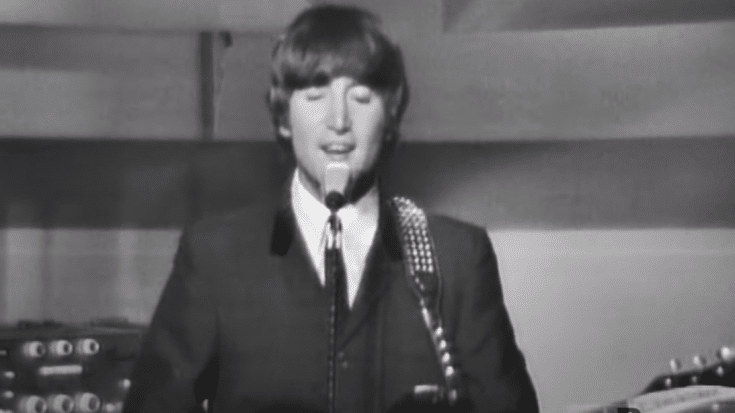We Explore How Good of A Guitarist John Lennon Is

via HDBeatles / Youtube
The influence of The Beatles on rock and roll music cannot be overstated. Following the groundbreaking sounds of Chuck Berry, Elvis Presley, and Roy Orbison, these four individuals from Liverpool created some of the most enduring music of the 1960s.
Many of their songs from that era are still regarded as exceptional examples of experimental rock art. Within the guitar community, a persistent question has always been whether John Lennon possessed genuine skills as a guitar player.
While Lennon’s songwriting remained a key component of The Beatles’ style throughout their existence, his technical skills as a musician were not very impressive. However, his attention was frequently on the beat.
In contrast, George Harrison supplied tasty solos to each song. Despite playing very simple guitar parts, Lennon developed a distinct technique that was difficult for others to imitate.
Early Style
Lennon initially began playing the banjo as a child, and his style on the instrument was initially quite rhythmic. If you listen to early Beatles songs like “I Want To Hold Your Hand” and their rendition of “Money (That’s What I Want),” you can hear Lennon hitting the strings forcefully, treating the banjo like a melodic drum. He consistently synchronized with Ringo Starr to introduce captivating syncopation into the music.
The Beat Behind the Guitar
While strumming chords was typically the primary method for rhythm guitar, Lennon developed unique habits through this technique. Despite songs like “And I Love Her” being primarily driven by Paul McCartney’s melody and Harrison’s guitar lick, Lennon played a crucial role in the background, providing a consistent pulse for the song to thrive upon.
However, it should be noted that Lennon was not devoid of leading moments. During the initial stages of The Beatles’ journey, Lennon occasionally took on guitar parts that served as leads, such as the swift triplets found in “All My Loving.”
While these parts mostly consisted of fundamental chords, executing them at such a fast pace required considerable skill. This ability was a result of the extensive time Lennon dedicated to studying the accompanying bands behind his beloved chart-toppers.
A similar argument can be presented regarding songs such as “Long Tall Sally,” where Lennon enhances the impact of Starr’s snare drum beats by intensifying the chord stabs. When you listen to the song, it’s simple to imagine Lennon thoroughly enjoying himself, playfully encouraging Starr to unleash even more energy while effortlessly transitioning between each chord.
Breaking Boundaries
As the 1960s progressed, Lennon began exploring unconventional guitar techniques beyond the usual chords. While he maintained his role in providing rhythm, Lennon sought opportunities to incorporate lead guitar elements into his playing, such as the memorable hook in “Norwegian Wood (This Bird Has Flown).” Despite possessing some unique guitar skills of his own, Lennon consistently downplayed his abilities as a guitarist.
Lennon consistently explained that he refrained from participating in musical collaborations because he considered himself lacking in musical knowledge, believing he would have felt out of place if he had joined artists such as Cream for impromptu performances at clubs.
However, after The Beatles stopped touring, Lennon had ample time to delve into their studio recordings, allowing him greater opportunity for musical exploration.
Captivating Harmony
While Lennon didn’t rely on a solid grasp of music theory for his lead breaks, his primary focus was on establishing a suitable atmosphere for the song. A good illustration of this is found in “Honey Pie” from The White Album.
Although Lennon’s lead line appears quite complex, his intention was often to mimic the sound of a 1920s clarinet on the recording. Rather than being concerned with scales or technical knowledge, Lennon prioritized what sounded harmonious for the song.
Over the decade, Lennon’s skills as a lead guitarist greatly improved, and his guitar solos in “Get Back” exemplified some of his most beautiful work. Despite his modest technical prowess, Lennon consistently embraced a bluesy style, finding inspiration in musicians like BB King and adopting a tasteful and controlled approach to his playing.
Solo Career Journey
His solo career in 1970 maintained the bluesy essence. As Lennon was the sole lead guitarist on the album Plastic Ono Band, a significant portion of his playing style drew from blues customs, incorporating various melodic pentatonic sequences and demonstrating expertise in skillfully bending guitar strings.
While Lennon’s musical approach had solidified by the conclusion of The Beatles’ journey, the ultimate demonstration of his abilities is exemplified in their last joint composition, “The End.”
Standout Guitar Solo
Concluding with a sequential guitar solo involving all three members of The Beatles, Lennon’s contribution stands out as the most intense, generating a fierce and gritty tone during his breaks, lending his guitar a raw and dirty sound.
While McCartney and Harrison each showcase their impressive guitar skills, Lennon’s memorable performance stands out, particularly during the concluding section where he demonstrates an intense effort to bend the strings off the fretboard.
Although this wasn’t a conventional guitar competition, Lennon’s limited expertise on the instrument might have actually worked in his favor.


















